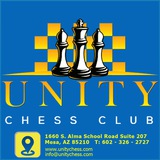Black had a curious defence, involving the sacrifice of the h6-pawn: 19...f5! 20.Qxh6 (20.exf6? Bxf6 would be strong if 21.Qxh6? wasn’t refuted by 21...Qxe3+) 20...Kf7! (with the idea of winning the queen by 21...Rh8) 21.Qh7+ Ke6 (now the threat is to repeat moves, starting with 22...Rh8) 22.Bh4! Qf7 23.Qxf7 Rxf7 24.Bxe7 Rxe7 – now White has an extra pawn and a decent advantage, but the win is far from assured.
Kashdan sacrifices the e5-pawn to quickly get his rooks into play. 22.exf4, with the idea of taking on g6 and playing f4- f5 again in order to permanently eliminate the black pawns on g6, was also strong.
22...Qxe5 23.Rcf1 Kg8 24.fxg6 fxg6 25.Qxh6 Qxe3+ 26.Kh1 Rxf4 27.Qxg6+ Kf8 28.Qd6+ Kg8 29.Rxf4 Qe1+ 30.Bf1 Re8 31.Qg6+ Kh8 32.Qh6+ Kg8 33.Rg4+
Unity Chess Club
Efim Geller Vassily Smyslov Zurich 1953 Black to move
Black has managed to create a perfect structure against the doubled c-pawns. How do we keep putting pressure on the position?
Now the black knight and bishop put pressure against c4 and this forces the white bishop and queen to protect it.
In this balanced position, one of the best players of the world from the last century and even an analyst of the ex-world champion Robert James Fischer came up with a very interesting strategic idea: trade the fianchettoed bishop for the centralized knight on e5.
